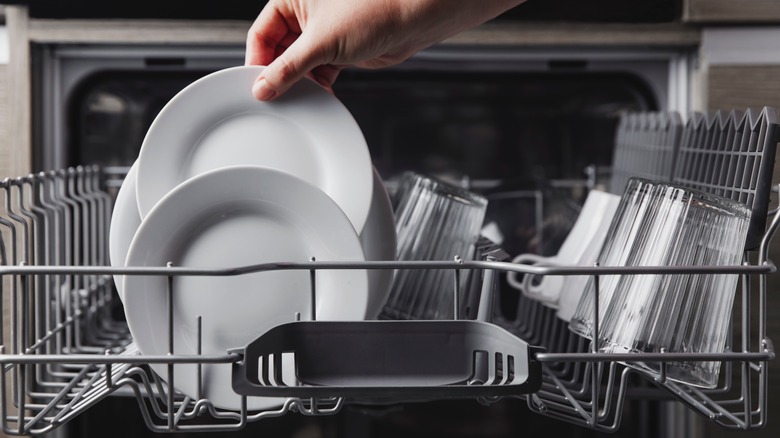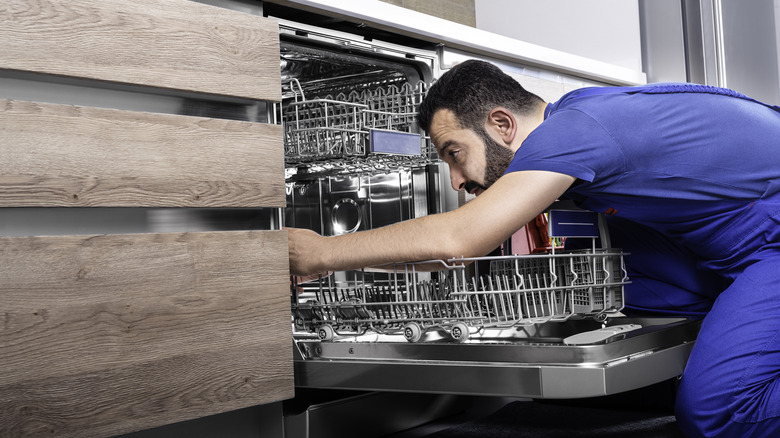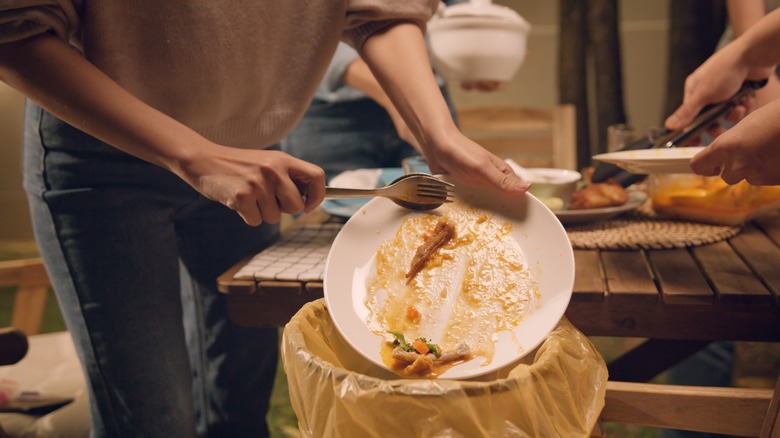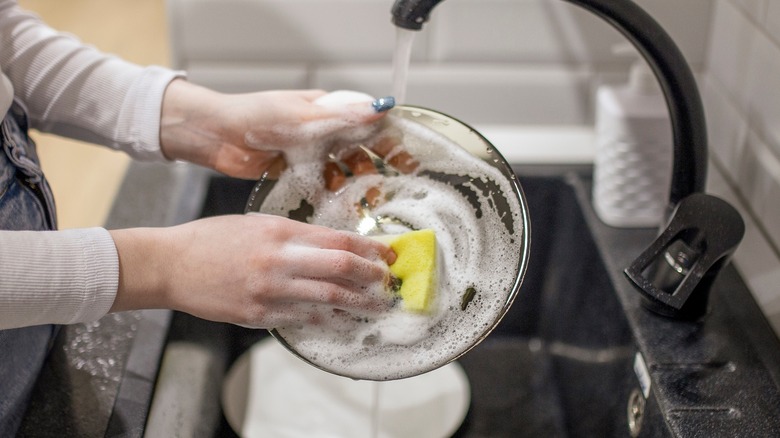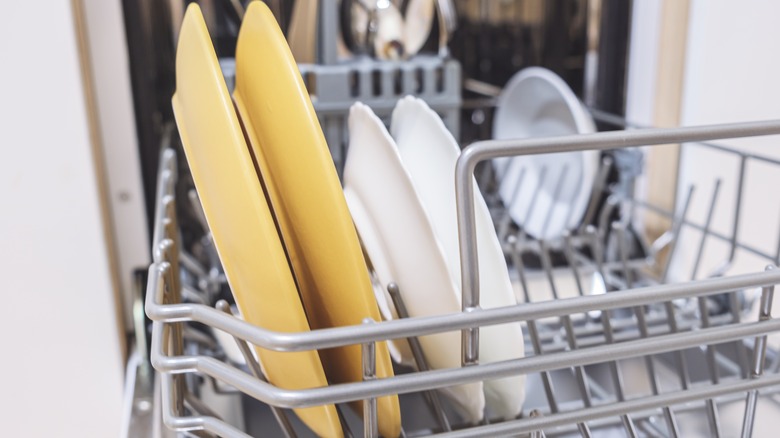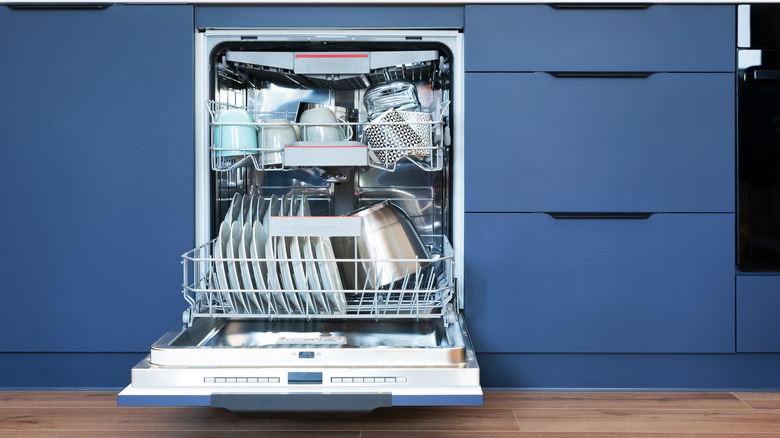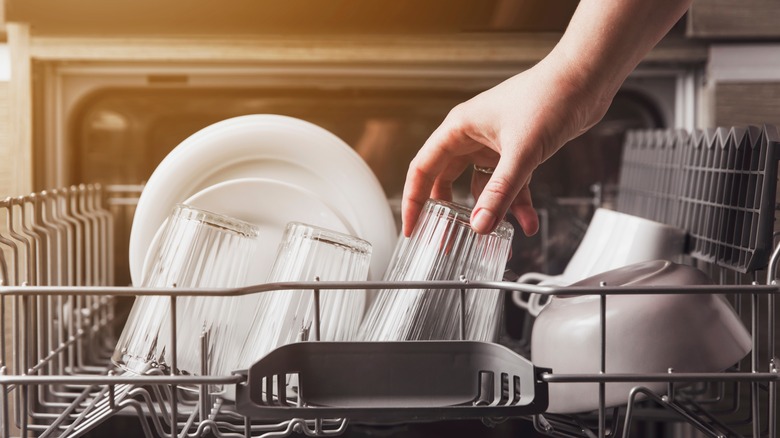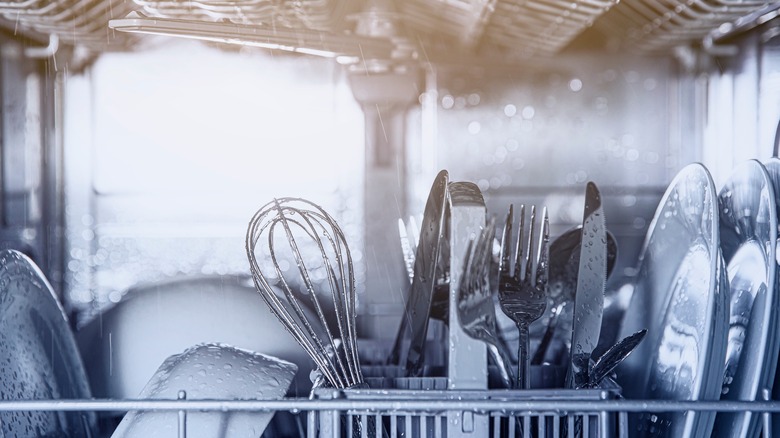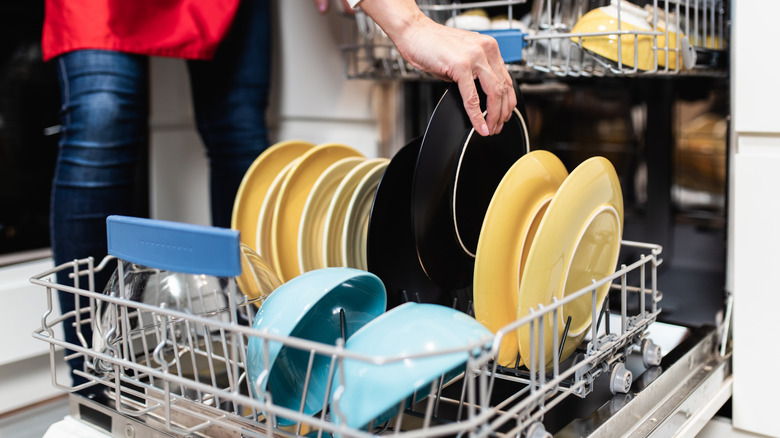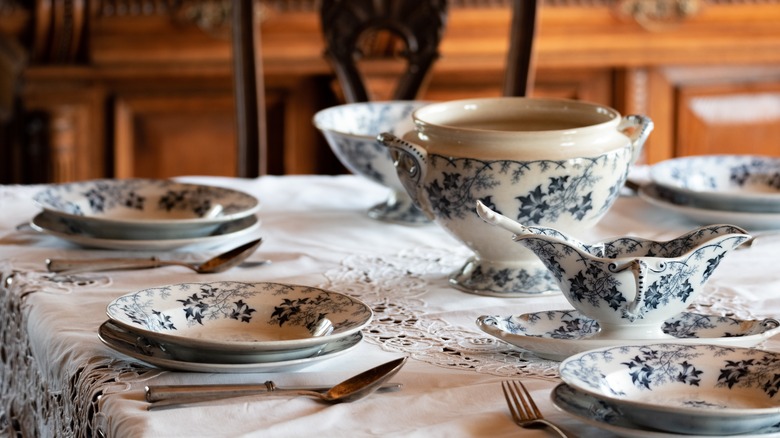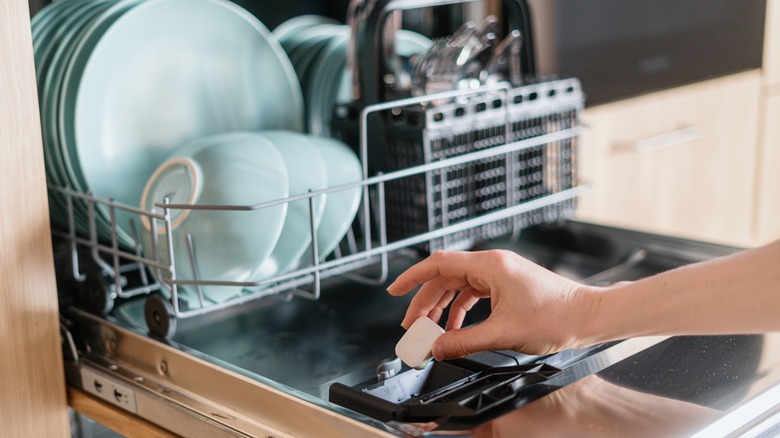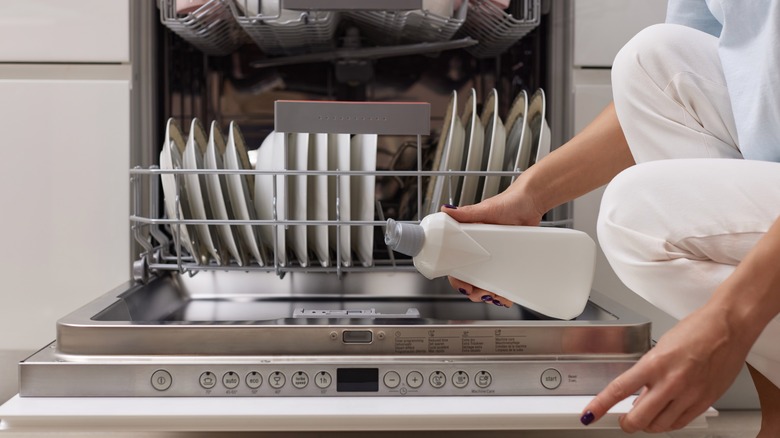13 Mistakes Everyone Makes While Loading A Dishwasher
Does anyone actually like washing dishes? Doing the dishes is a standard household task, but it's also one that never seems to end, especially if you live with multiple people. Dishes are constantly in a loop of use, wash, dry, put away, and repeat, making doing the dishes feel more annoying than most household chores. Luckily, dishwashers can make this task much easier ... as long as you're using them the right way.
The first type of dishwashing appliance was invented in 1850, and about 100 years later, dishwashers started becoming more commonplace in homes. Dishwashers not only save time but are better at cleaning dishes and better for the environment. To get these benefits, you have to be loading your dishwasher the right way. Still-dirty dishes and broken or damaged dishes are all signs that you're not loading your dishwasher properly. Below, we dive into common mistakes everyone makes while loading a dishwasher.
Not checking the filter
Inside your dishwasher is a filter. Its job is to catch bits of food and grease so that they don't end up back on the dishes during the wash cycle. Unfortunately, if the filter gets clogged, you'll end up with dishes that are dirty, greasy, and smelly, even after going through the dishwasher. Food isn't the only thing that can clog a dishwasher filter; hard water can leave minerals behind that leave a white or grayish coating on the filter. When your filter gets clogged, you'll need to clean it.
Now, you don't need to clean your filter every time you use the dishwasher. Typically, cleaning it every month or so is sufficient. However, it's good to give your filter a quick glance before you start loading up your dishwasher so you don't run it and end up with dirty dishes. You can wash a dirty filter in your kitchen sink. For general maintenance, a quick spray-down is usually enough, while a more grimy filter may require some soaking. A soft brush can help remove particularly stubborn bits or mineral build-up. You can also use vinegar to run your dishwasher to clean the inside.
Leaving food scraps on dishes
It can be tempting to load dirty dishes straight into the dishwasher, but that's not always the best option. As we've learned, a dishwasher's filter is meant to catch bits of food, and if it gets clogged, the dishes won't get cleaned. As a result, leaving chunks of meat, noodles, mashed potatoes, and other items that can gunk up your filter is a bad idea that will leave your dishes gross by the time the cycle is over.
Heavy clumps of food can also end up stuck in the racks, at the bottom of the dishwasher, or even on the dishes themselves. You may also notice your dishes feel greasy and slimy, or that they're covered with a thin layer of grit. Then you have no choice but to either wash everything by hand or run the dishwasher again. To make dishwashing a breeze, quickly scrape food chunks off of your dishes before loading them into the dishwasher. This also cuts down on the amount of work required to clean your filter.
Pre-rinsing the dishes
While food scraps should definitely not go in your dishwasher, you also don't want your dishes to be too clean. This might sound counterintuitive, but there's a reason: Modern dishwashers have sensors inside that detect how dirty the water is. The dishwasher then bases the run time of the cycle on how dirty the sensor indicates the dishwater is. When you pre-wash your dishes, the sensor can't accurately do its job.
In fact, you should try to avoid pre-rinsing your dishes to avoid confusing the sensor. Pre-rinsing is one of the biggest mistakes people make with their dishwashers. Not only does it mess with the sensor, but it takes extra time, energy, and water, and is just not necessary. Instead, all you need to do is scrape off those large food bits, and your dish is ready for the dishwasher. Of course, this doesn't apply to dishes with hardened or stuck food. Instead, soak these items first to soften the hardened food before adding them to the dishwasher, or just wash them by hand.
Only half-loading the dishwasher
Sometimes, you need to run a dishwasher even if it's not quite full. Maybe you really need the items cleaned, or maybe you're leaving for a few days and don't want to come back to rancid dishes. In general, though, it's best to avoid running a dishwasher that's not full yet, as doing so is bad for your wallet, your dishwasher, and the environment. That means that even if you want to run a half-full dishwasher just to get it done, it's a better idea to wait until it's full.
When you run multiple small loads of dishes instead of a couple of large ones, a few things happen. First, your dishwasher uses additional energy and water to run these loads. This isn't great for the environment and can cause your utility bills to skyrocket. On top of that, these extra loads put extra strain on the dishwasher, reducing its lifespan. This can also pinch your wallet, as it means you may need to purchase a new dishwasher sooner rather than later.
Overloading the dishwasher
On the flip side, there are times when the dishes pile up and you just want to cram everything in the dishwasher and be done with it. This is also not a good idea, because when you stuff the dishwasher too full, the dishwasher can't properly clean all your dishes. You'll end up with dishes that are still dirty and need to be hand-washed or run through again. This ultimately wastes water, electricity, and time.
Dishwashers work by spraying water through jets, usually located on the underside of each rack, sometimes on a spinner. When there are too many dishes in a dishwasher, the water from those jets can't reach all the dishes, which is why some dishes may come out clean, but others are still dirty. To ensure that your dishwasher jets can properly clean every dish inside of it, place all dishes in the dishwasher so that the sprayers have a clear path to the dirty parts of those dishes. This means no stacking dishes on top of each other or nesting bowls together.
Putting glasses and bowls facing up
The best way to make sure that your glasses and bowls are in the lines of the jets is to make sure they're face down, not face up. The "face," or the inside part of the cups and bowls, is where these dishes are the dirtiest, and if they're facing up, it's hard for the water to reach them. If you load them face up, you'll end up with cups and bowls still full of food residue.
You'll also end up with cups and bowls full of water. When water gets inside face-up glasses and bowls, it's almost impossible for the dishwasher to rinse that water out. Then you end up with a nasty surprise when you open the dishwasher to find your glasses and bowls full of dirty, grimy water.
Additionally, glasses and cups should go between, not over, your dishwasher tines. There are a few reasons to load them this way. First, they take up less space, allowing you to fit more on your top shelf. It also ensures an unencumbered path for the water jets and helps keep the cups from breaking.
Organizing utensils incorrectly
Some dishwashers today have a third top rack specifically for utensils and cutlery, but many still have an upright basket that goes on the bottom shelf. And just like people argue about pineapple on pizza or the best way to hang a roll of toilet paper, there's no clear consensus on how to organize utensils in an upright basket. However, there are a few clear things that you shouldn't do.
First, knives should always go into the cutlery basket with the sharp point down and the handles up so that no one gets injured loading or unloading the dishwasher. For this reason, many people prefer to load their forks with the tines down as well, although some argue that utensils get cleaner when they're in the basket handle-down. You also want to avoid nesting utensils in the basket, meaning you don't want your silverware to be nestled together the way it is in the drawer because this makes it difficult for the dishwasher to clean each individual utensil. Additionally, larger utensils, like spatulas and serving spoons, are often better off on the top shelf rather than in the baskets, as their height can block the spinning mechanism under the top rack.
Putting dishes on the wrong racks
To make sure each dish gets cleaned properly, there are a few general rules for what dishes go on what rack in the dishwasher. Typically, plates, large bowls, and pots and pans should go on the bottom rack, while mugs, glasses, and smaller bowls belong on the top rack. Dishes that are too tall for the top rack but forced there anyway can end up breaking, and too-large dishes may not get properly washed on the top rack. However, there are a few items that should always go on the top rack regardless of size or be hand-washed instead.
Many plastic items, like food storage containers or children's dishes, should be placed on the top rack instead of the bottom rack. This is because the heating element for the dishwasher is on the bottom, and this heating element could melt or otherwise damage plastic items. If you're unsure where something goes, check the bottom. Often, dishes that cannot go on the bottom rack are marked with a phrase like "top rack dishwasher safe only." This phrase may be underneath a symbol with a small plate and a larger plate under streams of water.
Loading delicate items on the bottom
While plastic shouldn't go on the bottom rack because it can melt, delicate items shouldn't go on the bottom rack because they can become damaged. This damage can include chips, cracks, or discoloration. These items should go on the top rack and may need special care. Some may also need to avoid the dishwasher entirely and be hand-washed instead.
Easily breakable items like china dishes belong on the top rack to keep them from the dishwasher's heating element and rougher jets. And while all glasses should go on the top rack, things like long-stemmed wine glasses should never go on the bottom to avoid breaking the stems. On top of that, some delicate items, like crystal or antique, hand-painted, or metal-rimmed china, should never go in the dishwasher and should only be hand-washed. If you're not sure of the best way to wash something, check the label. If there is no label, as might be the case with antiques, err on the side of caution and stick to handwashing, especially with items that are expensive or irreplaceable.
Washing hand wash-only items
Just like some items should only go on the top rack of the dishwasher, there are several items that shouldn't go in the dishwasher at all. Most of your everyday items are dishwasher safe; things made of hard plastic, glass, stoneware, and stainless steel are generally fine to wash in a dishwasher. However, there are several items that you might use all the time that you're better off handwashing.
Things you should never put in the dishwasher include silver and copper, as it can tarnish or become discolored, and cast iron and non-stick pans, as the dishwasher can remove the protective coating. Wood items shouldn't go in the dishwasher, as they can warp or crack. This includes cutting boards — washing wooden cutting boards in the dishwasher is a common cutting board mistake. Insulated mugs shouldn't go in the dishwasher because it could damage their seal and insulation. If you're not sure if an item can go in the dishwasher, always check the label. A "dishwasher safe" label usually has an image of a small and large plate under streams of water.
Placing the detergent in the wrong spot
Most people know that you need to use dishwashing detergent, not regular dish soap, for the dishwasher, but not everyone knows that where you put the detergent matters. While the specific location for dish detergent can vary, in general, dishwasher detergent should go in the dishwasher detergent compartment and nowhere else. This includes pods, unless your dishwasher has a specific compartment just for pods, as some models do.
Dish detergent hacks are common online, especially on platforms like TikTok, but for the most part, they should be ignored. Dishwashers are made so that they release the detergent at a specific time in the cycle, and putting the detergent elsewhere messes that up. No, you shouldn't put your detergent pod in your silverware basket or at the bottom of your dishwasher, as this can cause the detergent to release too early in the cycle and result in still-dirty dishes. If you toss it in the bottom, you also run the risk of the pod getting damaged by the heating element or even sticking to the heating element.
That being said, there is one exception to this rule, and that's if you're running an express cycle. However, all dishwashers and dish detergents are a little different, so check the instructions on your dish detergent and your dishwasher to be certain where your detergent should go.
Ignoring rinse aids
Many people view rinse aids similarly to the way they view fabric softener; it might be nice to have but is ultimately unnecessary. However, rinse aids, unlike fabric softeners, can be super helpful. It's not a necessity, but if you've never used a rinse aid before, you may want to try it. Rinse aids are made of acids, salts, and surfactants, and they do a couple of different things: They help dishes dry faster, and they also reduce food residue and hard water spots on dishes.
Some dish detergents include rinse aids, but not all do. In that case, you'll need to buy a separate rinse aid and add it to the rinse aid compartment. Your dishwasher should release the rinse aid at the proper time during the cycle. If you're still noticing hard water stains, not enough rinse aid is being released, and if you notice rainbow streaks on your dishes, that means too much rinse aid is being released. To fix this, check your manual for help adjusting the rinse aid settings.
Not reading the dishwasher manual
While the above tips will help you load your dishwasher more efficiently and reduce food residue, the truth is, all dishwashers are a little different. The absolute best way to learn how to load your dishwasher is to check your dishwasher manual. Within your manual, you should find instructions for how to load your specific model of dishwasher.
Your dishwasher manual can help in other ways, as well. It will show you where everything is, including the detergent compartment, rinse aid compartment, and filter. Your manual will also tell you where to load different types of detergent, and also explain what each setting does and how to adjust your settings. Manuals often also come with troubleshooting guides so you can fix minor problems.
If you bought your dishwasher brand new, it would have come with a manual. However, if your dishwasher is used, you may not have access to the manual. To find a manual for your dishwasher, look inside for the model number. A simple internet search for the brand and model number will often pull up an online manual.
